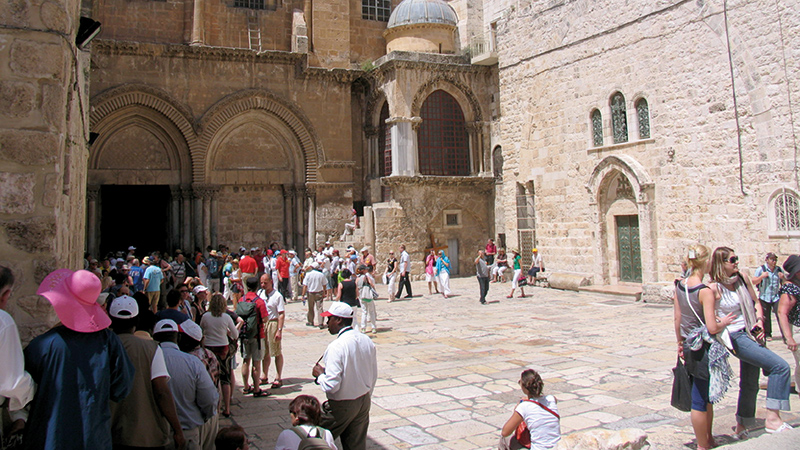Where is Jesus’ tomb?
April 1, 2017

As I write this (in October of 2016), archaeologists have just opened what many believe is the tomb where Jesus was placed following His crucifixion.
The tomb borrowed from the family of Joseph of Arimathea as the resting place of Jesus has for centuries been thought to lie under the Church of the Holy Sepulchre in Jerusalem. Which is only to say that somewhere back in time someone thought that spot was the place of Jesus’ burial and—like nearly every religious site in the Holy Land—built a church atop it.
Water damage to the foundations of the shrines built around and above the site meant that a marble slab that had covered the site since the 15th century had to be removed. No-one was quite sure what they’d find when they opened up the space. After cleaning away fill and debris, they uncovered another surface, this one cut into the limestone bedrock, with a cross carved into it. As the stone became visible, National Geographic Society archaeologist Fredrik Hiebert said into the camera recording the auspicious event, “My knees are shaking a little bit.” For the first time in centuries, human eyes were looking at the very stone upon which, some believed, Jesus’ body had rested for a few dozen hours two millennia ago.
An interesting discovery, but is it really Jesus’ grave? The likelihood is far from certain. It wasn’t until about 300 years after Christ that representatives of the Roman emperor Constantine (Constantine’s mother Helena may have been among them) journeyed to Palestine to identify the holy places of the Bible. But by then the centre of Christianity had long since moved north and west into Europe. Did the few remaining Palestinian Christians remember correctly where Jesus had been entombed, or did they merely sense an opportunity?
The Church of the Holy Sepulchre today caps 20 centuries of disturbance: the Crusades and other wars following the Muslim domination of Jerusalem, a dozen changes in Jerusalem’s rulership, several structures raised and razed on the tomb site, and inexpert digging and building by well-intentioned Christians. The most one can say is that this church is a spot that has been held sacred as the burial place of Jesus for centuries—but with little corroborating evidence.
The sepulcher’s competitors
In 1867, diggers unearthed a traditional hewn burial cave that they named the Garden Tomb because it was in a more rural setting outside of Jerusalem’s crowded Old City. Israeli archaeologists dated it to the seventh or eighth century, though that fact is often ignored by religious tourists, because in appearance it matches more closely the rock-hewn cave in a garden that the Bible describes (John 19:41) than does the overbuilt Holy Sepulchre. It has the added appeal of being located near and below a rock hill that had once been nicknamed “the skull”—the meaning of the word Golgotha, and even today it bears a striking resemblance to a skull.
More recently an ossuary—a stone box filled with bones—turned up that was inscribed “James, son of Joseph, brother of Jesus.” Archaeologists began to take it seriously when they found similar ossuaries in a tomb in Talpiot, a suburb of Jerusalem, with familiar names carved on them: Mary, Judah, Joseph. Most exciting was one, filled with bones like the rest, that says in Aramaic, “Jesus son of Joseph.”

Some immediately began calling it “the lost tomb of Jesus,” though researchers were quick to point out that all these names had been common in first-century Palestine. While the discovery led to several enthusiastic documentaries and at least one charge of fraud, in the end most authorities agreed that the results were as inconclusive as they were controversial. Said University of North Carolina historian James Tabor, “If you find the bones of Jesus, the resurrection is off.”
To this day, there’s no irrefutable evidence that any of these three sites was the resting place of Jesus—indeed, that they had anything to do with Jesus at all. And to Christians who trust the Bible’s account, it doesn’t matter very much anyway, because wherever that tomb is or was, Jesus isn’t in it!
The everywhere God
The first ones to document Jesus’ resurrection were women who’d gone to the tomb on the Sunday morning after the crucifixion to complete the burial preparation that had been interrupted by the Sabbath. There they found the tomb open and an angel, who said, “Do not be afraid, for I know that you are looking for Jesus, who was crucified. He is not here; he has risen, just as he said” (Matthew 28:5, 6). The angel identified the tomb as that of Jesus, and he quickly reminded them that Jesus had previously predicted His renewed life after death. Most importantly, he told them that Jesus was no longer there. No, His body had not been moved. Though completely dead for nearly two days, the angel said that He was now fully alive and walking about.
The angel’s invitation to “come and see the place where He lay” (verse 6) was not to declare holy the spot where Jesus’ corpse had been but to prove to the women that He was no longer there. And he told them that there was no reason for them to remain there, either. He told the women to “go quickly and tell his disciples, ‘He has risen from the dead and is going ahead of you into Galilee. There you will see him’ ” (verse 7).
Some religions emphasise geographical locations as essential to the faith. Think of Mecca for Muslims or the Ganges River for Hindus. In contrast, Christianity is not a religion of holy locations. While Palestine—today called Israel—was undoubtedly where Jesus was born and walked this planet, He never intended the faith He started to be concentrated there.
In fact, one of His final teachings was that His followers were to leave that place and “go into all the world and preach the gospel to all creation” (Mark 16:15). The reason He went away, He told them, was so He could send them a divine Presence that would be with them everywhere they went. “It is for your good that I am going away,” He said. “Unless I go away, the Advocate [that is, the Holy Spirit, who is present everywhere] will not come to you; but if I go, I will send him to you” (John 16:7).
Thus unhampered by Jesus’ physical presence, and with the Holy Spirit accompanying them, the disciples went enthusiastically “into all the world.” Peter and Paul, the Bible says, evangelised Europe. Other traditions give us reason to believe that Thomas may have travelled to India; Philip, Matthew and Bartholomew, into Africa; and Andrew, James son of Alpheus, and John, into Asia.
This is evidence of how little significance the early Christians placed on Palestine. Few returned until three centuries later, when the pagan-influenced Roman church began looking for holy places and relics. And for those who understood the story, there was no point in going to Jerusalem to find Jesus. His tomb was empty, for He had risen.
The religion of the empty tomb
There are many teachings that shape the faith of Christians, but this is perhaps the most beloved one: one Man came back from death, and because of that, so can the rest of us! The tomb was empty; Jesus wasn’t in it. As that one tomb was empty, so will all tombs be someday. “For we believe that Jesus died and rose again,” wrote Paul, “and so we believe that God will bring with Jesus those who have fallen asleep in him” (1 Thessalonians 4:14). Bodies lost at sea? “The sea gave up the dead that were in it,” says Revelation 20:13. Fragments of bones? “This is what the Sovereign Lord says to these bones: . . . I will attach tendons to you and make flesh come upon you and cover you with skin; I will put breath in you, and you will come to life” (Ezekiel 37:5, 6). And those of us buried in underground graves? “Let those who dwell in the dust wake up and shout for joy” (Isaiah 26:19).
That’s why Christians aren’t terribly concerned about where Jesus’ tomb was. For Jesus is not there. He’s alive “where two or three gather in my name” (Matthew 18:20). And the unending life He received He promises to give to us, too.









